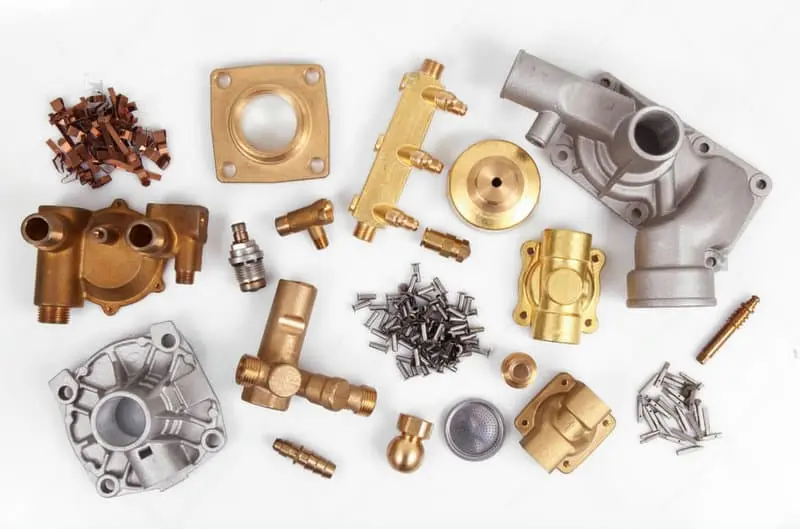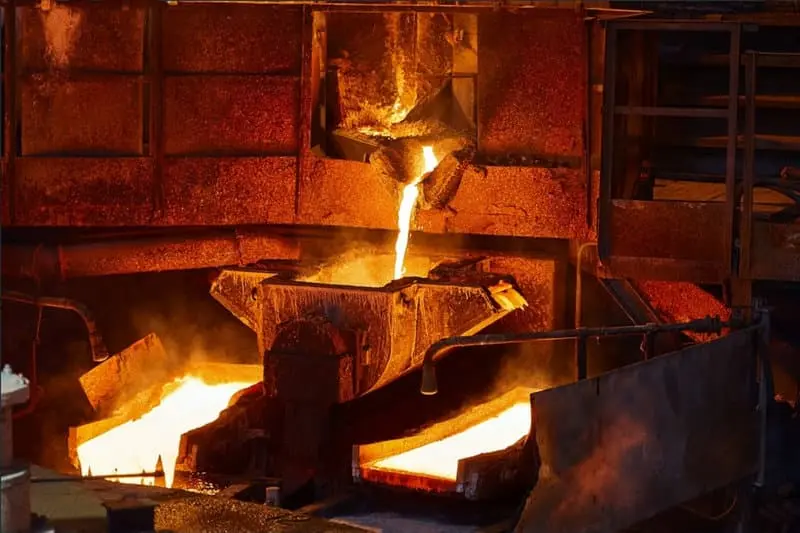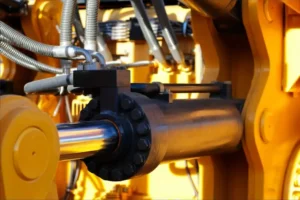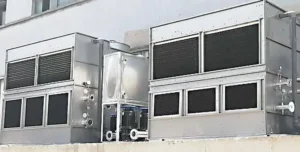الأنواع المختلفة من النحاس وسبائكه لها نقاط انصهار مختلفة. يذوب النحاس النقي في حوالي 1085 درجة مئوية, لكن سبائك النحاس المشتركة مثل البرونز والنحاس لها نقاط انصهار مختلفة.
- البرونز (سبيكة النحاس والقصدير): عادة ما تكون نقطة الانصهار بين 850 و 950 درجة مئوية, اعتمادًا على تكوين السبائك.
- النحاس (سبيكة النحاس والزنك): عادة ما تكون نقطة الانصهار بين 900 و 940 درجة مئوية, كما أنه يختلف حسب محتوى الزنك.
بعد ذوبان, عادة ما يتم تحسينه, يقذف, وتبريد لضمان جودة وخصائص الصب.
التكرير: أثناء عملية الذوبان, قد يتم إنتاج الشوائب. يمكن إزالة هذه الشوائب ويمكن تحسين نقاء النحاس عن طريق إضافة عوامل التكرير أو استخدام فراغ أو بيئة غاز خاملة.
صب: يتم سكب النحاس المنصهر في قالب مستعد مسبقًا لتشكيل الشكل المطلوب. اعتمادًا على طريقة الصب, صب الرمال, صب القالب المعدني, أو قد يتم اختيار عمليات أخرى.
تبريد: بعد تبريد الصب في القالب, عادة ما يتم رسمه. This step requires care to avoid damage to the casting.
Post-processing: After cooling, copper castings may undergo subsequent processes such as deburring, polishing, and heat treatment to improve their surface quality and mechanical properties.

Copper Refining
Copper refining is mainly to remove impurities and harmful elements from molten copper to improve its purity and performance.
- ذوبان: Melt the copper to a high temperature to make it liquid. At this stage, fluxing agents (such as fluorides) can be added to help remove impurities.
- Gas treatment: Using inert gases (مثل الأرجون) or vacuum environments can reduce the effects of oxidation and reactive gases, thereby improving the quality of copper.
- Dephosphorization: If copper contains phosphorus, it can be removed by heating or adding specific chemicals. الفوسفور المفرط يمكن أن يسبب هشاشة النحاس.
- التكرير الكهربائي: في الخلية الكهربائية, يتم استخدام النحاس المصهور كأنود ونحاس نقي يستخدم ككاثود. بعد تطبيق الطاقة, نحاس نقي يذوب من الأنود والودائع على الكاثود, وتبقى الشوائب في الخلية الكهربائية. يمكن أن يحقق التكرير الكهربائي نقاء نحاسي مرتفع للغاية (عادة أكثر من 99.9%).
صب النحاس
الصب هي عملية صب النحاس المنصهر في قالب لتشكيل شكل محدد.
- تحضير العفن: حدد مادة العفن المناسبة (مثل قالب الرمل, قالب معدني أو قالب الجص), والتأكد من أن سطح القالب ناعم وجاف لمنع الصب من الالتصاق.
- ذوبان النحاس: سخني النحاس إلى حالة منصهرة في فرن, التأكد من أن درجة حرارتها موحدة وتجنب البقع الباردة.
- صب: صب النحاس المنصهر بعناية في القالب, والنحاس ذي السيولة الجيدة يمكن أن يملأ كل تفاصيل القالب. في هذا الوقت, يجب التحكم في سرعة الصب وزاوية الميل لتقليل الفقاعات والعيوب.
تبريد النحاس
التبريد خطوة حاسمة في عملية الصب. والغرض الرئيسي هو تحويل النحاس المنصهر من السائل إلى الصلبة لتشكيل الشكل والخصائص المطلوبة.
- التبريد الطبيعي: يبرد الصب بشكل طبيعي في القالب, عادة من خلال توصيل الحرارة للهواء أو العفن. التبريد الطبيعي أبطأ ويساعد على تقليل الإجهاد الداخلي.
- التبريد القسري: في بعض الحالات, يمكن إجراء التبريد القسري باستخدام وسائط مثل الماء أو الرياح لتسريع عملية التبريد. هذا يمكن أن يحسن كفاءة الإنتاج, but the cooling rate needs to be controlled to prevent thermal stress from causing cracks.
- Cooling time: The cooling time depends on the thickness, shape and material of the casting. Thick castings require longer cooling time to ensure uniform solidification.
- Temperature monitoring: During the cooling process, it is important to monitor the temperature changes of the casting to ensure that it solidifies as expected.
- Demolding: After the casting has cooled to a sufficient hardness, the mold can be removed.
Post-processing
The post-processing process of copper usually includes the following:
- Deburring: After the casting is removed from the mold, there may be sharp burrs on the edges. Deburring is usually done by mechanical methods (such as grinding, cutting) or chemical methods (such as pickling) to ensure safety and improve appearance.
- Surface treatment: Copper castings may be cleaned and polished to remove oxide layers and other contaminants and improve surface gloss. Common methods include mechanical polishing, chemical polishing and electrolytic polishing.
- المعالجة الحرارية: Heat treatment can improve the mechanical properties of copper, such as increasing strength and toughness. Common heat treatment methods include annealing (heating followed by slow cooling) and quenching (rapid cooling), the specific choice depends on the alloy composition and end use of the copper.
- Coating: To improve corrosion resistance or change the appearance, copper castings can be coated, such as electroplating, spraying or painting. This can provide additional protection and improve the appearance of copper.
- Inspection and quality control: After post-processing is completed, the castings will undergo various inspections (مثل الفحص البصري, التفتيش بالموجات فوق الصوتية, فحص الأشعة السينية, إلخ.) لضمان تلبية متطلبات التصميم والأداء.








